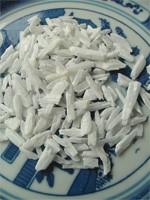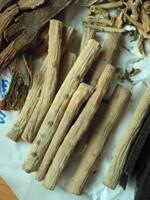FAQ for Chinese Herb Basics
- Chinese medicinal materials are composed of?
- Chinese medicinal materials have how many types?
- What are the usual dosage forms in Chinese herbal remedies?
- What are “Four Natures” and “Five Flavors” in Chinese medicines?
- What are Ascending, Descending, Floating, and Sinking effects in Chinese medicines?
- What is meant by applying herbs according to the meridians?
- How are herbs selected and combined in TCM prescriptions?
- What are “guiding herbs” and how do they work in TCM prescriptions?
- How TCM physicians determine the dosage of each ingredient in a herbal prescription?
- What Chinese medicines belong to endangered species, and have been prohibited to use?
- What are the authentic medicinal materials in TCM?
- Many Chinese medicinal materials were processed before using, for what purposes?
- How to identify the quality of Chinese medicines?
- How to store Chinese medicinal materials?
Q: Chinese medicinal materials are composed of?
A: Chinese medicinal materials refer to the drugs used under the guidance of Chinese medical theory; any substance can become a Chinese medicinal material.

Q: Chinese medicinal materials have how many types?
Q: What are the usual dosage forms in Chinese herbal remedies?
A: Traditionally, physicians suggest their patients to boil their prescriptions with water to make a soup for consumption, the so-called decoction. In addition to the form of decoction, there are other different preparing forms, such as traditional bolus, powders, ointments, pellets, and modern capsules, tablets, granules, syrups and even injections, which are in wide variety to meet the health needs of people.
Q: What are “Four Natures” and “Five Flavors” in Chinese medicines?
A: The “Four Natures” refer to the four medicinal properties of cold, cool, warm, and hot, and the “Five Flavors” are sour, bitter, sweet, pungent, and salty. These medicinal properties of Chinese medicines are summarized by the ancients based on the different reactions that appear after the medicines acted on the human body. For example, when people experience heat symptoms such as dry throat, constipation, and yellow urine, they can be relieved by taking herbs like golden thread rhizome and Chinese rhubarb, indicating that these herbs are cold or cool in property. If someone experience chills, fever, runny nose, and body aches that present a wind-cold syndrome, herbs like notopterygium root and ginger can relieve the signs, and therefore the herb can exert a warm and hot property. As for the Five Flavors, they will have different effects, for example, pungent herbs such as fresh ginger and onion have a sweating effect, sweet herbs such as red dates and pilose asiabell root have a tonic effect.
Since the Chinese medicines have different natures, flavors and attributions, which help evaluate their clinical actions, and so can be classified accordingly.
Q: What are Ascending, Descending, Floating, and Sinking effects in Chinese medicines?
 |
 |
 |
 |
| Ascending effect | Descending effect | Floating effect | Sinking effect |
Q: What is meant by applying herbs according to the meridians?
Q: How are herbs selected and combined in TCM prescriptions?
- Mutual Need (相須): This refers to the combination of herbs with similar properties and effects to enhance the original therapeutic effects. For example, when anemarrhena rhizome and gypsum are used together, their effects of heat-clearing or fire-purging are significantly enhanced.
- Mutual Enhancement (相使): This refers to the combination of herbs with the same or different properties, one as the main herb and the other as the adjuvant, to enhance the efficacy of the main herb. For example, when golden thread rhizome is used to treat dysentery, costus root can assist by smoothing bowel movements and arresting abdominal pain.
- Mutual Counteraction (相殺): This refers to one herb being able to reduce or eliminate the toxic side effects of another herb. For example, mung beans can kill the toxicity of croton.
- Mutual Restraint (相畏): This refers to when two herbs are used together, the toxicity or efficacy of one herb is inhibited by another. For example, pinellia and arisaema are restrained by fresh ginger.
- Mutual Antagonism (相惡): This refers to when two herbs are used together, one herb weakens the original effect of another herb, such as the invigoration effect of ginseng can be inhibited by radish seed, fresh ginger reduces the effects of baical skullcap root.
- Mutual Inhibition (相反): This refers to when two herbs are used together, they produce strong side effects; for example, liquorice root will increase the toxicity of lilac daphne flower bud.
- Single Use (單行): This refers to a herb used alone in order to exert its own specific action, e.g. ginseng alone is enough to replenish inborn qi in a short time.
Q: What are “guiding herbs”? How do they work in TCM prescriptions?
- Harmonize and enhance the actions: For example, in wind-heat type influenza when individuals present with a high fever and thirst, bamboo leaf and reed rhizome are used. The two herbs work together can strengthen the effects of clearing heat and bringing down the fever.
- Guide other herbs to work on specific meridians: For example, pain in the lower limbs and feet, achyranthes root is usually selected to act as a guiding role, so that other herbal effects travel to the painful location.
- Reduce toxicity: Large blister beetle is usually prescribed to treat liver cancer; however this insect is very toxic, mung beans would also be used as the guiding herb to prevent harmful effects from occurring.
- Improve taste: For example, the fishy smell of some animal products can be eliminated by millet wine. Ingredients like honey, malt sugar and sugar cane juice are often used to make herbs more palatable.
Q: What are Chinese medicine decoction pieces?
Q: How TCM physicians determine the dosage of each ingredient in a herbal prescription?
Q: What Chinese medicines belong to endangered species, and have been prohibited to use?
- I Grade: Rare and precious wild medicinal material species on the verge of extinction, such as tigers (tiger bones), Saiga antelopes (antelope horns), sika deer (sika deer velvet), etc.
- II Grade: Important wild medicinal material species whose distribution area has shrunk, and the resources are in a state of exhaustion, such as liquorice root, ginseng, golden thread rhizome, eucommia bark, and tokay etc.
- III Grade: Major commonly used wild medicinal material species with severely reduced natural resources, such as ledebouriella root, Chinese senega, Manchurian wildginger, and dendrobium etc.
Q: What are the authentic medicinal materials in TCM?
A: This refers to those that belong to a specific geographical origin and production area, processed locally, with a recognized source, and have a definite and reliable therapeutic effect. The efficacy of a Chinese medicines is determined by the amount of active ingredients it contains, and the amount of active ingredients is closely related to the ecological growing environment of the herb, such as soil, water quality, climate, etc. The famous authentic medicinal materials include angelica root from Gansu province; wolfberry from Ningxia province; golden thread rhizome, Sichuan lovage rhizome and unibract fritillary bulb from Sichuan province; poria and notoginseng from Yunnan province; cordyceps from Tibet; Asian ginseng from Jilin province. Most physicians prefer to use these authentic medicinal materials to ensure the quality and therapeutic efficacy of their prescriptions.
Q: Many Chinese medicinal materials were processed before using, for what purposes?
A: The purpose of processing herbs can be summarized as below:
- Reduce or eliminate the toxicity and side effects of drugs: Herbs like aconite root, common Monkshood mother root, Kusnnezoff Monkshood root, pinellia tuber, Jackinthepulpit tuber, and nux vomica are very likely to be poisoned when taken orally; their toxicities and irritations can be greatly reduced after being processed.
- Enhance efficacy: For example, honey-roasted common coltsfoot flower has better moisturizing and cough-relieving effects than its raw one; and pinellia tuber processed with ginger juice can enhance its antiemetic effect.
- Change the medicinal properties of herbs and widen their applications: For example, fresh rehmannia root is used to cool blood, while processed rehmannia root can nourish blood; medicinal evodia fruit is used to stop vomiting by stir-fried with golden thread rhizome solution, to treat hernia by processed with salt, to expel coldness and relieve pain by processed with ginger, to calm the liver and relieve pain by processed with vinegar, and to relieve qi stagnation in the heart or abdomen by processed with wine.
- Change the target parts or enhance tendencies of drug action: A Chinese herb can have multiple effects, that are not all applicable to a certain clinical condition. For example, ephedra is mainly for respiratory problems especially asthma or cough, however for those who accompanied with sweating, the herb’s perspiring effect is not favorable. After being roasted with honey, this unwanted effect is restrained, the asthmatic or cough arresting effect is enhanced too, making ephedra suitable for asthmatic or coughing conditions.
- Convenient for dispensing and preparation: For example, mineral and shell-like drugs with hard texture must be processed to make them crispy, which is convenient for preparation, also helps the release of active ingredients.
- Maintain purity: Most Chinese medicinal materials cannot be used in raw, as various impurities are often mixed, a certain standard of cleanliness and purity must be achieved before use.
- Facilitate storage and use: the usual procedures like roasting, baking, and frying can absorb the moisture of medicinal materials, kill insect eggs, and remove special odors. Processed with wine, salt and vinegar can be preserved for longer time.



